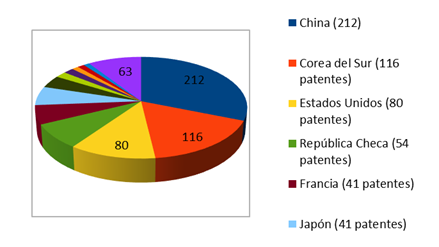Situación actual de la síntesis y utilización de geopolímeros
Palabras clave:
geopolímeros, aluminio-silicatos, activación alcalina, inteligencia tecnológicaResumen
El cemento es uno de los materiales de construcción más ampliamente utilizados a nivel mundial. Por cada tonelada producido se emite una de CO2 a la atmósfera, adicionalmente, su elaboración requiere un gasto energético implicando las afectaciones ambientales propias de la actividad minera. Una alternativa ecoamigable la representa los materiales geopoliméricos, los cuales son matrices poliméricas inorgánicas que pueden cumplir la función aglutinante del cemento, cuya producción minimiza la huella de carbono. Los geopolímeros pueden ser elaborados empleando como precursores residuos industriales ricos en óxidos de silicio y aluminio, mediante un proceso de activación alcalina, representando una alternativa para la revalorización de muchos pasivos ambientales, permitiendo producir concretos de hasta 50 Mpa de resistencia a la compresión. En la presente investigación se elaboró un análisis bibliométrico y patentométrico de las tendencias actuales en la utilización y síntesis de geopolímeros, así como, de la evolución del proceso tecnológico durante los últimos 20 años. Para ello, se desarrolló una ecuación de búsqueda y posteriormente se empleó la plataforma Patent Inspiration para el análisis de patentes y Thomson Reuters para las publicaciones científicas. Se encontró que los países líderes en el patentamiento de esta tecnología son China, Corea y Estados Unidos. La presente cartografía de los geopolímeros posibilita dar a conocer esta innovación tecnológica para el desarrollo de materiales de construcción amigables con el ambiente los cuales aún no han sido investigados ampliamente en Venezuela
Descargas
Citas
J. Davidovits, “Global Warming IMpact on the Cement and Aggregates Industries,” World Resour. Rev., vol. 6, no. 2, pp. 263–278, 1994
D. Hardjito, S. E. Wallah, Dody M. J. Sumajouw, and B. V. Rangan, “On the Development of Fly Ash-Based Geopolymer Concrete,” no. February, 2016
A. Neville, “Chloride Attack of Reinforcement Conccrete an Overview.Pdf,” Materials and Structures, vol. 28. pp. 63–70, 1995
J. Davidovits, “Properties of Geopolymer Cements,” First Int. Conf. Alkaline Cem. Concr., pp. 131–149, 1994
“Search and analyze patents - PatentInspiration.” [Online]. Available: http://www.patentinspiration.com/
“Home | Thomson Reuters.” [Online]. Available: https://www.thomsonreuters.com/en.html.
A. Mehta and R. Siddique, “An overview of geopolymers derived from industrial by-products,” Constr. Build. Mater., vol. 127, pp. 183–198, 2016
S. O. Sore, A. Messan, E. Prud’homme, G. Escadeillas, and F. Tsobnang, “Synthesis and characterization of geopolymer binders based on local materials from Burkina Faso – Metakaolin and rice husk ash,” Constr. Build. Mater., vol. 124, pp. 301–311, 2016
E. Nimwinya et al., “A Sustainable Calcined Water Treatment Sludge and Rice Husk Ash Geopolymer,” J. Clean. Prod., 2016
J. G. S. Van Jaarsveld, J. S. J. Van Deventer, and L. Lorenzen, “The potential use of geopolymeric materials to immobilise toxic metals: Part I. Theory and applications,” Miner. Eng., vol. 10, no. 7, pp. 659–669, 1997
S. Lee, A. van Riessen, C. M. Chon, N. H. Kang, H. T. Jou, and Y. J. Kim, “IMpact of activator type on the immobilisation of lead in fly ash-based geopolymer,” J. Hazard. Mater., vol. 305, pp. 59–66, 2016
H. W. Nugteren, M. B. Ogundiran, G. Witkamp, and M. T. Kreutzer, “Coal fly ash activated by waste sodium aluminate solutions as an immobilizer for hazardous waste,” 2011 World Coal Ash Conf., pp. 1–10, 2011
D. C. Comrie, J. H. Paterson, and D. J. Ritcey, “Applications of Geopolymer Technology to Waste Stabilization,” Third Int. Conf. New Front. Hazard. Waste Manag. Proc., p. 161–165r604, 1989
L. Zheng, W. Wang, and Y. Shi, “The effects of alkaline dosage and Si/Al ratio on the immobilization of heavy metals in municipal solid waste incineration fly ash-based geopolymer,” Chemosphere, vol. 79, no. 6, pp. 665–671, 2010
Z. Yunsheng, S. Wei, C. Qianli, and C. Lin, “Synthesis and heavy metal immobilization behaviors of slag based geopolymer,” J. Hazard. Mater., vol. 143, no. 1–2, pp. 206–213, 2007
A. D. Cozzi, C. J. Bannochie, P. R. Burket, C. L. Crawford, and C. M. Jantzen, “Immobilization of radioactive waste in fly ash based geopolymers,” 2011 World Coal Ash Conf. – May 9-12, 2011 Denver, CO, USA, 2011
J. Temuujin et al., “Utilization of radioactive high-calcium Mongolian flyash for the preparation of alkali-activated geopolymers for safe use as construction materials,” Ceram. Int., vol. 40, no. PB, pp. 16475–16483, 2014
R. A. A. Boca Santa, C. Soares, and H. G. Riella, “Geopolymers with a high percentage of bottom ash for solidification/immobilization of different toxic metals,” J. Hazard. Mater., vol. 318, pp. 145–153, 2016
Q. Li et al., “Immobilization of simulated radionuclide 133Cs+by fly ash-based geopolymer,” J. Hazard. Mater., vol. 262, pp. 325–331, 2013
P. Sazama, O. Bortnovsky, J. Dědeček, Z. Tvaržková, and Z. Sobalík, “Geopolymer based catalysts-New group of catalytic materials,” Catal. Today, vol. 164, no. 1, pp. 92–99, 2011
S. Candamano, P. Frontera, A. Macario, F. Crea, J. B. Nagy, and P. L. Antonucci, “Preparation and characterization of active Ni-supported catalyst for syngas production,” Chem. Eng. Res. Des., vol. 96, pp. 78–86, 2015
S. Sharma, D. Medpelli, S. Chen, and D. K. Seo, “Calcium-modified hierarchically porous aluminosilicate geopolymer as a highly efficient regenerable catalyst for biodiesel production,” RSC Adv., vol. 5, no. 80, pp. 65454–65461, 2015
R. M. Novais, L. H. Buruberri, M. P. Seabra, and J. A. Labrincha, “Novel porous fly-ash containing geopolymer monoliths for lead adsorption from wastewaters,” J. Hazard. Mater., vol. 318, pp. 631–640, 2016
T. Luukkonen et al., “Removal of ammonium from municipal wastewater with powdered and granulated metakaolin geopolymer,” Environ. Technol. (United Kingdom), vol. 39, no. 4, pp. 414–423, 2018
Y. Ge, Y. Yuan, K. Wang, Y. He, and X. Cui, “Preparation of geopolymer-based inorganic membrane for removing Ni2+from wastewater,” J. Hazard. Mater., vol. 299, pp. 711–718, 2015
M. Naghsh and K. Shams, “Synthesis of a kaolin-based geopolymer using a novel fusion method and its application in effective water softening,” Appl. Clay Sci., vol. 146, no. March, pp. 238–245, 2017
Y. Zhang and L. Liu, “Fly ash-based geopolymer as a novel photocatalyst for degradation of dye from wastewater,” Particuology, vol. 11, no. 3, pp. 353–358, 2013
E. Jämstorp, J. Forsgren, S. Bredenberg, H. Engqvist, and M. Strømme, “Mechanically strong geopolymers offer new possibilities in treatment of chronic pain,” J. Control. Release, vol. 146, no. 3, pp. 370–377, 2010
J. Forsgren, C. Pedersen, M. Strømme, and H. Engqvist, “Synthetic geopolymers for controlled delivery of oxycodone: Adjustable and nanostructured porosity enables tunable and sustained drug release,” PLoS One, vol. 6, no. 3, 2011
B. Cai, H. Engqvist, and S. Bredenberg, “Evaluation of the resistance of a geopolymer-based drug delivery system to tampering,” Int. J. Pharm., vol. 465, no. 1–2, pp. 169–174, 2014
“Geopolymer Institute – Promoting the geopolymer science since 1979.” [Online]. Available: https://www.geopolymer.org/
“Wagners.” [Online]. Available: https://www.wagner.com.au/
“Advance Concrete and Cement - Geopolymer Solutions.” [Online]. Available: http://www.geopolymertech.com/
“VOSviewer - Visualizing scientific landscapes.” [Online]. Available: http://www.vosviewer.com/
P. Duxson, A. Fernández-Jiménez, J. L. Provis, G. C. Lukey, A. Palomo, and J. S. J. Van Deventer, “Geopolymer technology: The current state of the art,” J. Mater. Sci., vol. 42, no. 9, pp. 2917–2933, 2007
A. Palomo, M. W. Grutzeck, and M. T. Blanco, “Alkali-activated fly ashes: A cement for the future,” Cem. Concr. Res., vol. 29, no. 8, pp. 1323–1329, 1999
H. Xu and J. S. J. Van Deventer, “The geopolymerisation of alumino-silicate minerals,” Int. J. Miner. Process., vol. 59, no. 3, pp. 247–266, 2000
P. Duxson, J. L. Provis, G. C. Lukey, S. W. Mallicoat, W. M. Kriven, and J. S. J. Van Deventer, “Understanding the relationship between geopolymer composition, microstructure and mechanical properties,” Colloids Surfaces A Physicochem. Eng. Asp., vol. 269, no. 1–3, pp. 47–58, 2005

Publicado
Cómo citar
Número
Sección

Está obra está bajo licencia Creative Commons Attribution-NonCommercial-ShareAlike 4.0 International License.
Las opiniones expresadas por los autores no necesariamente reflejan la postura del editor de la publicación ni de la UCLA. Se autoriza la reproducción total o parcial de los textos aquí publicados, siempre y cuando se cite la fuente completa y la dirección electrónica de esta revista. Los autores(as) tienen el derecho de utilizar sus artículos para cualquier propósito siempre y cuando se realice sin fines de lucro. Los autores(as) pueden publicar en internet o cualquier otro medio la versión final aprobada de su trabajo.






.png)




